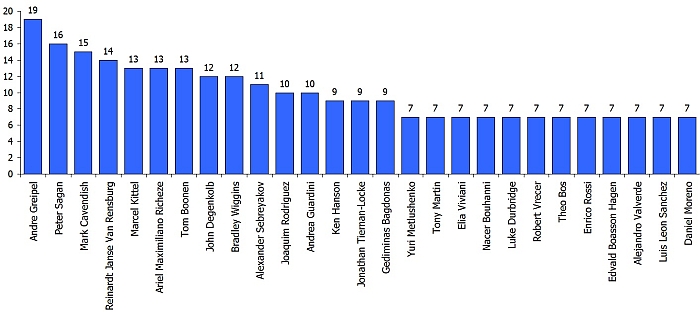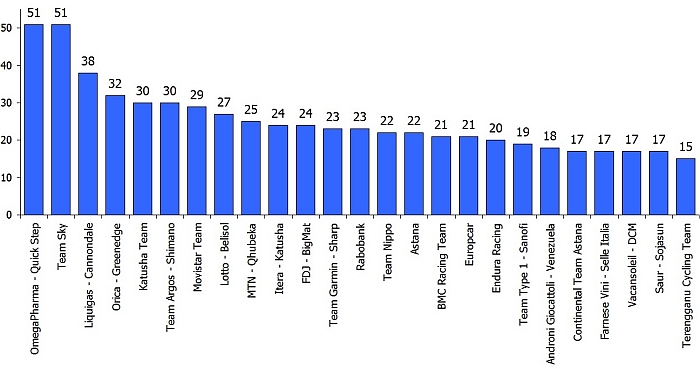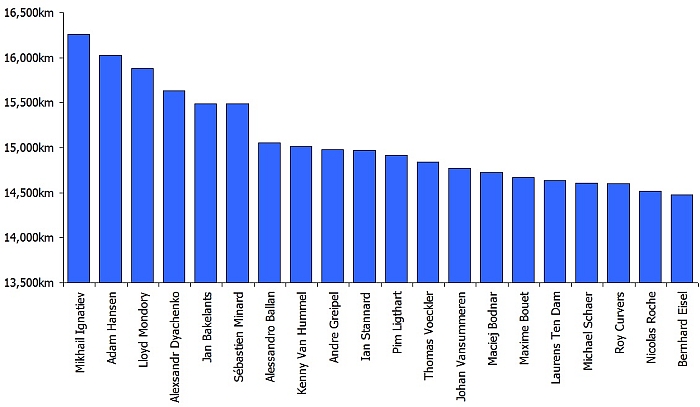I enjoy cycling for the suspense, drama and action. But analysis sometimes means using cold numbers and hard data and often these confound what we think. Here’s a look back at 2012 via some numbers, from the most victorious rider of the year to the nation with the most pro wins as well as other stats from the season.
The numbers below are based on all UCI races rated .2 and above, so all the pro races. This pits big teams against small ones and explains why some relatively unknown riders and teams can appear alongside bigger names below but the point here is the sheer numbers rather than an evaluation of quality.

This shows just how open the sport is, that the most victorious rider only takes a small percentage of the wins available. We’ll return to other means of measuring Greipel’s success below.
Next as cycling is a team sport let’s look at the most victorious teams of 2012.

Omega Pharma-Quickstep top the charts and with Mark Cavendish on his way they could do even better in 2013 but the remarkable thing with OPQS has been the diversity of wins with several riders racking up the wins. Orica-Greenedge had a great start with 32 wins, very impressive for a new squad but at the same time their roster is packed with sprinters and fastmen so they’ve played the numbers right and collected lots of wins in the year. But they don’t yet have many GC contenders and mountain men for the big Tour, where even Matthew Goss was a little bit short of Greipel, Cavendish and Sagan in July. Still on raw numbers it’s great. Note Lotto-Belisol on 27 wins, meaning André Greipel is responsible for over two thirds of the team’s success. Plus FDJ might be worried about ejection from the World Tour but it’s done well in the quantity of wins, especially with sprinters neo-pro sprinters Arnaud Démare and Nacer Bouhanni. Note the development teams of Astana and Katusha on the chart above alongside the main teams, they’ve had a very good year and it bodes well for Kazakh and Russian cycling.
Now talking of nations here are the countries ranked by wins:

The sport might be spreading but note the dominance of Italy, France and Spain. Germany is interesting because of its sprinters with Greipel, Kittel and Degenkolb winning plenty whilst Tony Martin has done very well and so has Stefan Schumacher, the disgraced rider is racking up wins in smaller races around the world. And if you think the British had a good year, the Russians won more.
Whilst Schumacher is collecting plenty of airmiles as he races in Asia, the king of road miles is Mikhail Ignatiev of Katusha.

Ignatiev has ridden a total of 16,257km to beat Adam Hansen’s 16,025km. It’s not on the chart but the Russian also “wins” with 104 days of racing compared to Hansen on 103 days. I hope these riders have had a good off-season.
Note André Greipel on the chart again here, he’s done 14,978km in 89 days of racing. This means he’s won 21% of the races he has finished, a one-in-five success rate and the same winning rate as Peter Sagan from his 73 days of racing. By contrast Mark Cavendish is on 17.9%, still a phenomenal rate. If these three riders start a race then there’s a good chance one will win it but don’t do the arithmetic of adding 21% + 21% + 17.9% to make a 59.9% chance this trio will win against the others because of course the numbers are often derived when the riders in question are competing in different races. For example in May Cavendish rode the Giro, Sagan the Tour of California and Greipel had a rest for most of the month.
Conclusion
There are many statistics to toy with and here we’ve seen a few obvious ones. In cycling some wins are worth a lot more than others and so the absolute count of victories needs some relative analysis. But in a mist of statistics André Greipel stands out. Yes most races finish in sprints so it’s normal that sprinters come to the fore but Greipel seems to win on quantity and quality too. And despite the Gorilla name he’s not really the chest-thumping type. Instead he’s polite, a gentle giant and a delight for his sponsors. His website, if infrequently updated, is good example of a rider giving a personal take.
But cycling is a team sport and Greipel’s wins mean success for his team mates, whether those who work directly or just the whole outfit. It’s less prevalent than it used to be since salaries count for more but repeated wins means repeated bonuses and teams like OPQS and Sky will enjoy the wins and the winnings too.
- All the source data is from Cycling Quotient where you’ll find other rankings and data


As mentioned, Lotto are in the UCI danger zone, despite a larger number of wins. Is this due to the ranking (as an example) favouring good positions in GC rather than race wins itself?
Yes, the points suit steady GC riders who might not win but ride consistently. Don’t forget Jurgen Van den Broeck was also fourth in the Tour so he got plenty of points there for the team. But the squad don’t have too many other winners on board, just a lot of helpers for Greipel and VdB, more so if Meersman is going. They needed an Iranian last year to top up the points.
Very interesting breakdown. I am looking forward to this coming season’s Cavendish – Greipel battle, now that Cavendish will have a full sprint train throughout.
Likewise. I’ve been thinking about some of the highlights of 2012 with ideas of a season review and Greipel and Cavendish did not meet very often this year but the Tour was one moment and the sprints with Sagan and others were great. A shame Kittel was sick.
Yes, there were some great sprint finishes but a real shame we didn’t get a 3 way battle. As it stands Cavendish and Greipel are still a clear cut above everyone else. It would have been interesting to see if Kittel was at the same level on the flatest of finishes. Here’s to next year!
And missing from the top teams was …. Team Dope …. once Sparticus went down they had nobody left …
This is good information. I would really like to see this type of data and more similar to it analysed much more deeply, something similar to a ‘moneyball’ approach. What would be great would be some analysis that would help identify a riders true ‘worth’ to his team, via his total contribution towards the collection of UCI points and also not forgetting prize money.
If you like Moneyball, see my “Moneywheel” post and the guest piece on cyclingnews.com that relates to:
http://www.cyclingnews.com/blogs/inner-ring/how-to-play-the-cycling-numbers-game
MTN-Qhubeka????
had to look that team up…never saw them in any televised raced…
You will next year as they will be Africa’s first team in the UCI Pro Continental level, cycling’s second level of teams alongside Cofidis, United Healthcare, Europcar, Colombia-Coldeportes etc
Minor nit to pick – I wish the graphs were laid out with text names on the vertical so I don’t have to tilt my head to try and read them. I can get the relative length of the bar just the same if it was horizontal.
Good work!
Noted, useful feedback.
Amazing performance by Reinhardt Janse van Rensburg, watch out for him next year when he joins Argos-Shimano